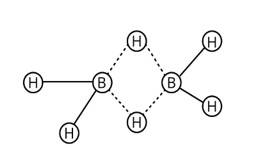Chemistry NCERT Exemplar Solutions Class 11th Chapter Eleven
Get insights from 115 questions on Chemistry NCERT Exemplar Solutions Class 11th Chapter Eleven, answered by students, alumni, and experts. You may also ask and answer any question you like about Chemistry NCERT Exemplar Solutions Class 11th Chapter Eleven
Follow Ask QuestionQuestions
Discussions
Active Users
Followers
New answer posted
5 months agoContributor-Level 10
This is a Multiple Choice Questions as classified in NCERT Exemplar
(A) & (B)
The atomic radii decrease as one moves down the group from Al to Ga due to the shielding effect of electrons. As a result of this ineffective effect, the effective nuclear charge rises.
New answer posted
5 months agoContributor-Level 10
This is a Multiple Choice Questions as classified in NCERT Exemplar
B
Cement is made by combining lime ( CaO ), clay with silica ( SiO), and oxides of aluminum, magnesium, and iron.
New answer posted
5 months agoContributor-Level 10
This is a Multiple Choice Questions as classified in NCERT Exemplar
C
Explanation:
Solid CO2 is referred to as dry ice because it is used in laboratories to create an ice bath for organic reactions. It is made by rapidly cooling high-pressure CO2 gas.
New answer posted
5 months agoContributor-Level 10
This is a Multiple Choice Questions as classified in NCERT Exemplar
D
Reducing agent are compound that donates electron to an electron recipient compound. Reducing agents oxidize themselves and reduce the other compounds. They easily lose electrons and increase their oxidation state; those electrons are accepted by electron needed compounds.
In SnCl2, Sn is in +2 oxidation state and can easily lose its two electrons and oxidize to +4 stable oxidation state.
New answer posted
5 months agoContributor-Level 10
This is a Multiple Choice Questions as classified in NCERT Exemplar
B
Quartz is a crystalline form of silica that can be converted into other crystalline forms at high temperatures. It's commonly used as a piezoelectric material.
New answer posted
5 months agoContributor-Level 10
This is a Multiple Choice Questions as classified in NCERT Exemplar
A
A compound X, of boron, reacts with NH3 on heating to give another compound Y which is called inorganic benzene.
3H2H6 x + 6NH3 → 3 [BH2 (NH3)2]+ [BH4]− 2 B3N3H6 + &n
New answer posted
5 months agoContributor-Level 10
This is a Multiple Choice Questions as classified in NCERT Exemplar
B
The four terminal hydrogen atoms and two boron atoms are all in the same plane.
There are two bridging hydrogen atoms above and below this plane.
The four terminal B-H bonds are regular two-centre-two-electron bonds, whereas the two bridge (B-H-B) bonds are unique and can be described as three-centre-two-electron bonds, as shown in figure:

New answer posted
5 months agoContributor-Level 10
This is a Multiple Choice Questions as classified in NCERT Exemplar
D
In group 13, the standardised trend of decrease of ionization enthalpy is not monitored.
As we move from Boron to Aluminium the atomic size increases and jonjation enthalpy decreases but when we move ahead from Aluminum to Gallium, the screening effect of 3 d electrons comes into play. The poor shielding effect of the electrons lead to the increase in nuclear charge on the valence electrons and results in increase of jopisation enthalpy.
Moving from gallium to Indium, due to the shielding effect of 4 d electrons the ionization enthalpy decreases.
The decre
New answer posted
5 months agoContributor-Level 10
This is a Multiple Choice Questions as classified in NCERT Exemplar
C
Me3SiCl is a soleuless liquid That has a major application in the formation of silicones. On its addition in the process, it blocks the end and controls the chain length of the polymer.

New answer posted
5 months agoContributor-Level 10
This is a Multiple Choice Questions as classified in NCERT Exemplar
B
In group 14, as we move down from C to Sn, the size increases and electronegativity decreases. This results in the decrease in M-M bond energy. Hence the catenation property decreases.
Bond energy is the amount of energy required to fragment the atoms combined in a molecule are born into separate atoms. Carbon has maximum bond energy as compared to its other group elements. Therefore, shows maximum catenation property.
Taking an Exam? Selecting a College?
Get authentic answers from experts, students and alumni that you won't find anywhere else
Sign Up on ShikshaOn Shiksha, get access to
- 65k Colleges
- 1.2k Exams
- 682k Reviews
- 1800k Answers
